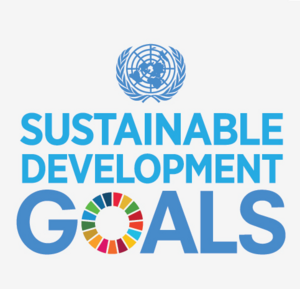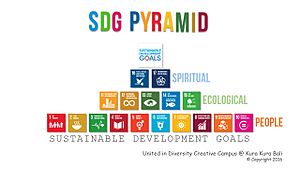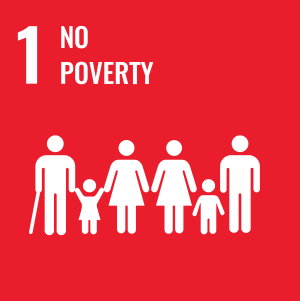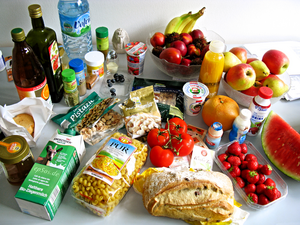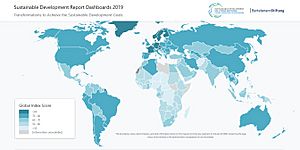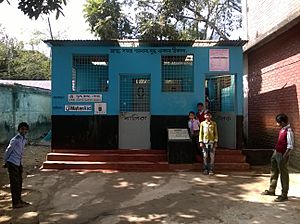Sustainable Development Goals facts for kids
The Sustainable Development Goals (SDGs) are a set of targets relating to future international development. They are created by the United Nations and promoted as the Global Goals for Sustainable Development. They replaced the Millennium Development Goals that expired at the end of 2015. The SGDs run from 2015 to 2030. There are 17 goals and 169 specific targets for those goals.
Contents
- The 17 goals
- Goal 1: No Poverty
- Goal 2: Zero Hunger
- Goal 3: Good Health and Well-being
- Goal 4: Quality Education
- Goal 5: Gender Equality
- Goal 6: Clean Water and Sanitation
- Goal 7: Affordable and Clean Energy
- Goal 8: Decent Work and Economic Growth
- Goal 9: Industry, Innovation and Infrastructure
- Goal 10: Reduced Inequalities
- Goal 11: Sustainable Cities and Communities
- Goal 12: Responsible Consumption and Production
- Goal 13: Climate Action
- Goal 14: Life Below Water
- Goal 15: Life on Land
- Goal 16: Peace, Justice and Strong Institutions
- Goal 17: Partnerships for the Goals
- Images for kids
- See also
The 17 goals
Goal 1: No Poverty
No Poverty - End poverty in all its forms everywhere
- Extreme poverty has been cut by more than half since 1990- however, more than 1 in 5 people live on less than $1.25 a day
- Poverty is more than lack of income or resources- it includes lack of basic services, such as education, hunger, social discrimination and exclusion, and lack of participation in decision making.
- Gender inequality plays a large role in the perpetuation of poverty and its risks; They then face potentially life-threatening risks from early pregnancy, and often lost hopes for an education and a better income.
- Age groups are affected differently when struck with poverty; its most devastating effects are on children, to whom it poses a great threat. It affects their education, health, nutrition, and security. It also negatively affects the emotional and spiritual development of children through the environment it creates.
Goal 2: Zero Hunger
Zero Hunger - End hunger, achieve food security and improved nutrition and promote sustainable agriculture
- Globally, 1 in 9 people are undernourished, the vast majority of these people live in developing countries
- Agriculture is the single largest employer in the world, providing livelihoods for 40 per cent of today’s global population. It is the largest source of income and jobs for poor rural households. Women comprise on average 43 per cent of the agricultural labor force in developing countries, and over 50 per cent in parts of Asia and Africa, yet they only own 20% of the land.
- Poor nutrition causes nearly half (45 per cent) of deaths in children under five – 3.1 million children each year.
Goal 3: Good Health and Well-being
Good Health and Well-being - Ensure healthy lives and promote well-being for all at all ages
- Significant strides have been made in increasing life expectancy and reducing some of the common killers associated with child and maternal mortality, and major progress has been made on increasing access to clean water and sanitation, reducing malaria, tuberculosis, polio and the spread of HIV/AIDS.
- However, only half of women in developing countries have received the health care they need
- An important target is to substantially reduce the number of deaths and illnesses from pollution-related diseases.
Goal 4: Quality Education
Quality Education - Ensure inclusive and equitable quality education and promote lifelong learning opportunities for all
- Major progress has been made for education access, specifically at the primary school level, for both boys and girls. However, access does not always mean quality of education, or completion of primary school. Currently, 103 million youth worldwide still lack basic literacy skills, and more than 60 per cent of them are women
- Target 1 "By 2030, ensure that all girls and boys complete free, equitable and quality primary and secondary education leading to relevant and Goal-4 effective learning outcomes"- shows the commitment to nondiscriminatory education outcomes
Goal 5: Gender Equality
Gender Equality - Achieve gender equality and empower all women and girls
- Providing women and girls with equal access to education, health care, decent work, and representation in political and economic decision-making processes will fuel sustainable economies and benefit societies and humanity at large
- While a record 143 countries guaranteed equality between men and women in their Constitutions by 2014, another 52 had not taken this step. In many nations, gender discrimination is still woven through legal and social norms
- Though goal 5 is the gender equality stand-alone goal, the SDG's can only be successful if women are completely integrated into each and every goal
Goal 6: Clean Water and Sanitation
Clean Water and Sanitation - Ensure availability and sustainable management of water and sanitation for all
The first three out of eight targets include:
- "By 2030, achieve universal and equitable access to safe and affordable drinking water for all."
- "By 2030, achieve access to adequate and equitable sanitation and hygiene for all and end open defecation, paying special attention to the needs of women and girls and those in vulnerable situations."
- "By 2030, improve water quality by reducing pollution, eliminating dumping and minimizing release of hazardous chemicals and materials, halving the proportion of untreated wastewater and substantially increasing recycling and safe reuse globally."
Goal 7: Affordable and Clean Energy
Affordable and Clean Energy - Ensure access to affordable, reliable, sustainable and modern energy for all
Goal 8: Decent Work and Economic Growth
Decent Work and Economic Growth - Promote sustained, inclusive and sustainable economic growth, full and productive employment and decent work for all
Goal 9: Industry, Innovation and Infrastructure
Industry, Innovation and Infrastructure - Build resilient infrastructure, promote inclusive and sustainable industrialization and foster innovation
Goal 10: Reduced Inequalities
Reduced Inequalities - Reduce income inequality within and among countries
Goal 11: Sustainable Cities and Communities
Sustainable Cities and Communities - Make cities and human settlements inclusive, safe, resilient and sustainable
Goal 12: Responsible Consumption and Production
Responsible Consumption and Production - Ensure sustainable consumption and production patterns
Goal 13: Climate Action
Climate Action - Take urgent action to combat climate change and its impacts by regulating emissions and promoting developments in renewable energy
Goal 14: Life Below Water
Life Below Water - Conserve and sustainably use the oceans, seas and marine resources for sustainable development
Goal 15: Life on Land
Life on Land - Protect, restore and promote sustainable use of terrestrial ecosystems, sustainably manage forests, combat desertification, and halt and reverse land degradation and halt biodiversity loss
Goal 16: Peace, Justice and Strong Institutions
Peace, Justice and Strong Institutions - Promote peaceful and inclusive societies for sustainable development, provide access to justice for all and build effective, accountable and inclusive institutions at all levels
Goal 17: Partnerships for the Goals
Partnerships for the Goals - Strengthen the means of implementation and revitalize the global partnership for sustainable development
Images for kids
See also
 In Spanish: Objetivos de Desarrollo Sostenible para niños
In Spanish: Objetivos de Desarrollo Sostenible para niños


